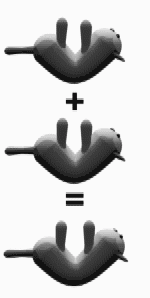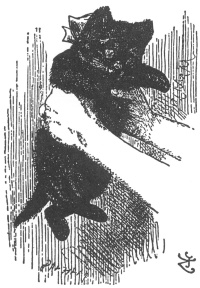Click to play embedded YouTube video.
Work hours for cats?
Work hours for cats?
The poor kitties in Japan are overworked! Now their working hours will be limited to twelve hours a day! 




Ann
Color Commentator
Re: Work hours for cats?
ha-ha-ha, i think they're just trying to avoid any future catastrophes 

To find the Truth, you must go Beyond.
- neufer
- Vacationer at Tralfamadore
- Posts: 18805
- Joined: Mon Jan 21, 2008 1:57 pm
- Location: Alexandria, Virginia
Re: Work hours for cats?
Beyond wrote:
ha-ha-ha, i think they're just trying to avoid any future catastrophes
Catastrophe, n. [L. catastropha, Gr. , fr. to turn up and down, to overturn; down + to turn.]
http://en.wikipedia.org/wiki/Falling_cat_problem wrote:<<The falling cat problem consists of explaining the underlying physics behind the common observation of the cat righting reflex: how a free-falling cat can turn itself right-side-up as it falls, no matter which way up it was initially, without violating the law of conservation of angular momentum.
Although somewhat amusing, and trivial to pose, the solution of the problem is not as straightforward as its statement would suggest. The apparent contradiction with the law of conservation of angular momentum is resolved because the cat is not a rigid body, but instead is permitted to change its shape during the fall. The behavior of the cat is thus typical of the mechanics of deformable bodies.
The solution of the problem, originally due to (Kane & Scher 1969), models the cat as a pair of cylinders (the front and back halves of the cat) capable of changing their relative orientations. Montgomery (1993) later described the Kane–Scher model in terms of a connection in the configuration space that encapsulates the relative motions of the two parts of the cat permitted by the physics. Framed in this way, the dynamics of the falling cat problem is a prototypical example of a nonholonomic system (Batterman 2003), the study of which is among the central preoccupations of control theory. A solution of the falling cat problem is a curve in the configuration space that is horizontal with respect to the connection (that is, it is admissible by the physics) with prescribed initial and final configurations. Finding an optimal solution is an example of optimal motion planning (Arbyan & Tsai 1998; Xin-sheng & Li-qun 2007).
In the language of physics, Montgomery's connection is a certain Yang-Mills field on the configuration space, and is a special case of a more general approach to the dynamics of deformable bodies as represented by gauge fields (Montgomery 1993; Batterman 2003), following the work of Shapere and Wilczek (Shapere and Wilczek 1987).>>
http://en.wikipedia.org/wiki/Catastrophe_%28drama%29 wrote:<<In drama, particularly the tragedies of classical antiquity, the catastrophe is the final resolution in a poem or narrative plot, which unravels the intrigue and brings the piece to a close. In comedies, this may be a marriage between main characters; in tragedies, it may be the death of one or more main characters. It is the final part of a play, following the protasis, epitasis, and catastasis. The catastrophe is either simple or complex, for which also the fable and action are denominated. In a simple catastrophe, there is no change in the state of the main characters, nor any discovery or unravelling; the plot being only a mere passage out of agitation, to quiet and repose. This catastrophe is rather accommodated to the nature of the epic poem, than of the tragedy.
- [color=#0000FF][i][b]Chapter 10 - Shaking[/b] She took her off the table as she spoke, and shook her backwards and forwards with all her might. The Red Queen made no resistance whatever; only her face grew very small, and her eyes got large and green: and still, as Alice went on shaking her, she kept on growing shorter -- and fatter -- and softer -- and rounder -- and -- [b]Chapter 11 - Waking[/b] -- And it really was a kitten, after all.[/i][/color]
In a complex catastrophe, the main character undergoes a change of fortune, sometimes by means of a discovery, and sometimes without. The qualifications of this change are that it be probable and necessary: in order to be probable, it must be the natural result or effect of the foregoing actions, i.e. it must spring from the subject itself, or take its rise from the incidents, and not be introduced merely to serve a turn.
The discovery in a complex catastrophe must have the same qualifications as the catastrophe itself, of which it is a principal part: it must be both probable and necessary. To be probable, it must spring out of the subject itself; not effected by means of marks or tokens, rings, bracelets, or by a mere recollection, as is frequently done both in ancient and modern times. To be necessary, it must never leave the characters it concerns in the same sentiments they had before, but still produce either love or hatred, etc. Sometimes, the change consists in the discovery, sometimes it follows at a distance, and sometimes results immediately from it; the last was used, for example, in Oedipus Rex.
In the twentieth century, J.R.R. Tolkien distinguished between what he called the catastrophe and the eucatastrophe. The eucatastrophe is a classical catastrophe with an unexpected positive outcome for the protagonist. This term was coined to distance itself from the vernacular use of the word 'catastrophe' to signify disaster (which gave the term negative connotations in everyday usage).>>
Art Neuendorffer

